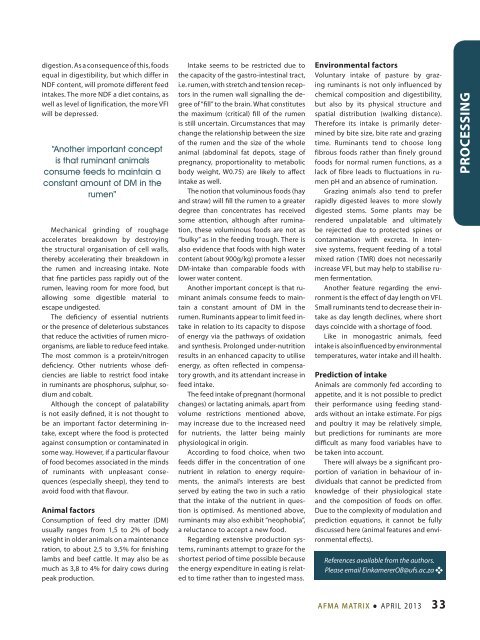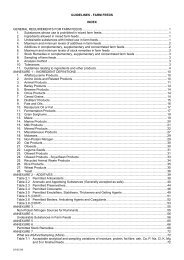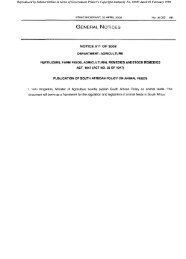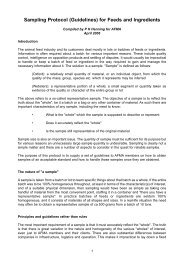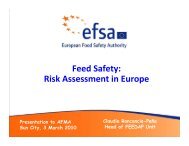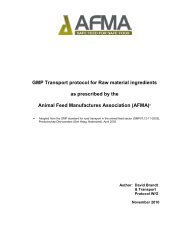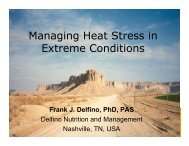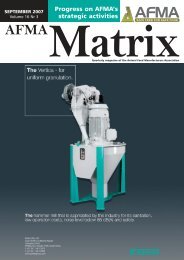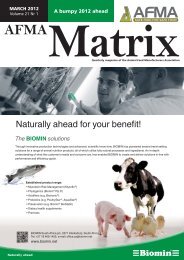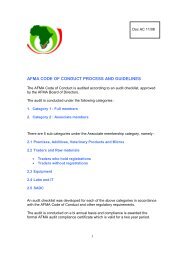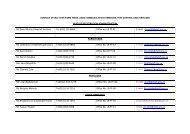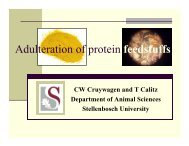Create successful ePaper yourself
Turn your PDF publications into a flip-book with our unique Google optimized e-Paper software.
digestion. As a consequence of this, foods<br />
equal in digestibility, but which differ in<br />
NDF content, will promote different feed<br />
intakes. The more NDF a diet contains, as<br />
well as level of lignification, the more VFI<br />
will be depressed.<br />
“Another important concept<br />
is that ruminant animals<br />
consume feeds to maintain a<br />
constant amount of DM in the<br />
rumen”<br />
Mechanical grinding of roughage<br />
accelerates breakdown by destroying<br />
the structural organisation of cell walls,<br />
thereby accelerating their breakdown in<br />
the rumen and increasing intake. Note<br />
that fine particles pass rapidly out of the<br />
rumen, leaving room for more food, but<br />
allowing some digestible material to<br />
escape undigested.<br />
The deficiency of essential nutrients<br />
or the presence of deleterious substances<br />
that reduce the activities of rumen microorganisms,<br />
are liable to reduce feed intake.<br />
The most common is a protein/nitrogen<br />
deficiency. Other nutrients whose deficiencies<br />
are liable to restrict food intake<br />
in ruminants are phosphorus, sulphur, sodium<br />
and cobalt.<br />
Although the concept of palatability<br />
is not easily defined, it is not thought to<br />
be an important factor determining intake,<br />
except where the food is protected<br />
against consumption or contaminated in<br />
some way. However, if a particular flavour<br />
of food becomes associated in the minds<br />
of ruminants with unpleasant consequences<br />
(especially sheep), they tend to<br />
avoid food with that flavour.<br />
Animal factors<br />
Consumption of feed dry matter (DM)<br />
usually ranges from 1,5 to 2% of body<br />
weight in older animals on a maintenance<br />
ration, to about 2,5 to 3,5% for finishing<br />
lambs and beef cattle. It may also be as<br />
much as 3,8 to 4% for dairy cows during<br />
peak production.<br />
Intake seems to be restricted due to<br />
the capacity of the gastro-intestinal tract,<br />
i.e. rumen, with stretch and tension receptors<br />
in the rumen wall signalling the degree<br />
of “fill” to the brain. What constitutes<br />
the maximum (critical) fill of the rumen<br />
is still uncertain. Circumstances that may<br />
change the relationship between the size<br />
of the rumen and the size of the whole<br />
animal (abdominal fat depots, stage of<br />
pregnancy, proportionality to metabolic<br />
body weight, W0.75) are likely to affect<br />
intake as well.<br />
The notion that voluminous foods (hay<br />
and straw) will fill the rumen to a greater<br />
degree than concentrates has received<br />
some attention, although after rumination,<br />
these voluminous foods are not as<br />
“bulky” as in the feeding trough. There is<br />
also evidence that foods with high water<br />
content (about 900g/kg) promote a lesser<br />
DM-intake than comparable foods with<br />
lower water content.<br />
Another important concept is that ruminant<br />
animals consume feeds to maintain<br />
a constant amount of DM in the<br />
rumen. Ruminants appear to limit feed intake<br />
in relation to its capacity to dispose<br />
of energy via the pathways of oxidation<br />
and synthesis. Prolonged under-nutrition<br />
results in an enhanced capacity to utilise<br />
energy, as often reflected in compensatory<br />
growth, and its attendant increase in<br />
feed intake.<br />
The feed intake of pregnant (hormonal<br />
changes) or lactating animals, apart from<br />
volume restrictions mentioned above,<br />
may increase due to the increased need<br />
for nutrients, the latter being mainly<br />
physiological in origin.<br />
According to food choice, when two<br />
feeds differ in the concentration of one<br />
nutrient in relation to energy requirements,<br />
the animal’s interests are best<br />
served by eating the two in such a ratio<br />
that the intake of the nutrient in question<br />
is optimised. As mentioned above,<br />
ruminants may also exhibit “neophobia”,<br />
a reluctance to accept a new food.<br />
Regarding extensive production systems,<br />
ruminants attempt to graze for the<br />
shortest period of time possible because<br />
the energy expenditure in eating is related<br />
to time rather than to ingested mass.<br />
Environmental factors<br />
Voluntary intake of pasture by grazing<br />
ruminants is not only influenced by<br />
chemical composition and digestibility,<br />
but also by its physical structure and<br />
spatial distribution (walking distance).<br />
Therefore its intake is primarily determined<br />
by bite size, bite rate and grazing<br />
time. Ruminants tend to choose long<br />
fibrous foods rather than finely ground<br />
foods for normal rumen functions, as a<br />
lack of fibre leads to fluctuations in rumen<br />
pH and an absence of rumination.<br />
Grazing animals also tend to prefer<br />
rapidly digested leaves to more slowly<br />
digested stems. Some plants may be<br />
rendered unpalatable and ultimately<br />
be rejected due to protected spines or<br />
contamination with excreta. In intensive<br />
systems, frequent feeding of a total<br />
mixed ration (TMR) does not necessarily<br />
increase VFI, but may help to stabilise rumen<br />
fermentation.<br />
Another feature regarding the environment<br />
is the effect of day length on VFI.<br />
Small ruminants tend to decrease their intake<br />
as day length declines, where short<br />
days coincide with a shortage of food.<br />
Like in monogastric animals, feed<br />
intake is also influenced by environmental<br />
temperatures, water intake and ill health.<br />
Prediction of intake<br />
Animals are commonly fed according to<br />
appetite, and it is not possible to predict<br />
their performance using feeding standards<br />
without an intake estimate. For pigs<br />
and poultry it may be relatively simple,<br />
but predictions for ruminants are more<br />
difficult as many food variables have to<br />
be taken into account.<br />
There will always be a significant proportion<br />
of variation in behaviour of individuals<br />
that cannot be predicted from<br />
knowledge of their physiological state<br />
and the composition of foods on offer.<br />
Due to the complexity of modulation and<br />
prediction equations, it cannot be fully<br />
discussed here (animal features and environmental<br />
effects).<br />
References available from the authors.<br />
Please email EinkamererOB@ufs.ac.za<br />
<br />
Processing<br />
<strong>AFMA</strong> MATRIX ● APRIL <strong>2013</strong> 33


